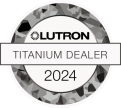Why Lighting Design? Part 3.
In the third and final installment of our blog series covering the effects of lighting on our health and quality of life we will be covering the changing world of lighting technology.
For better or worse, most new homes now feature LED lighting. The efficiency of LED fixtures is well documented, but many have never been happy with details such as color, quality, and dimming performance. Modern LED fixtures now have the ability to more closely match traditional incandescent lighting in all of those categories, along with one really special trick.
LED technology allows a nearly infinite amount of control over the color of light emitted by a fixture. This allows the tuning of light to match the look desired within a space. Incandescent light, while beautiful, was limited in the color temperature it provided. LED manufacturers have also made huge strides in improving the quality of light they emit, with high CRI (Color Rendering Index) options available at almost all price points. The biggest improvements in LED technology are related to dimming performance. High quality LEDs, when specified correctly, no longer suffer from flickering and erratic performance. In fact, higher performance fixtures can now dim to candlelight levels when combined with the correct dimmers. Additionally, dim-to-warm technology allows LED bulbs to shift in color, much like an incandescent bulb does when dimmed. This provides that warm, candle-lit, atmosphere perfect for a date night or just a relaxing evening at home.
Without question, the most exciting improvement in LED lighting is circadian rhythm lighting, also known as human-centric lighting. Our body is designed to use cues from the environment to maintain natural rhythms. In fact, our eyes feature photoreceptors other than the rods and cones we have always heard about, known as melanopsin receptors. These receptors do not help us form images, but instead transfer information about our environment directly to the suprachiasmatic nucleus (SCN), the part of our brain that manages our sleep/wake cycle. Recent studies appear to show that these receptors are very sensitive to blue wavelengths of light, which are present in our smartphones, computer monitors and LED light fixtures.
Those same studies also seem to show that the SCN expects to see that wavelength of light in the early morning and uses this cue to synchronize our internal clock with the world around us. When we expose our bodies to bright lights in the same wavelengths in the evening it may inhibit our ability to complete the restorative processes naturally run during sleep, among a number of other negative outcomes.
The potential effects of this technology are huge and include improved mood, better sleep, increased productivity and even better healing. A field study was performed at the Maastricht University Medical Center in the Netherlands with impressive results. Both patients and hospital staff reported higher satisfaction, while patient fell asleep faster, stayed asleep longer and reported enhanced mood as measured by the Hospital Anxiety and Depression Scale.
Human centric lighting is a key tool in biophilic design, one of the hottest trends in interior design. By mimicking the color and intensity of the sun, we hope to roll back some of the damage we have done by flooding our workplaces and homes with artificial light. BRAVAS partners like Ketra and USAI already have human-centric products on the market, and our clients are already seeing the benefits using them.
As we continue down the road to controlling both the artificial and natural light in our homes, we will continue to make them into the sanctuaries they were always intended to be. If you want help identifying opportunities to be happier and more comfortable in your home, please don’t hesitate to reach out to your local BRAVAS partner today. Just click the link below to find the BRAVAS location nearest you.



